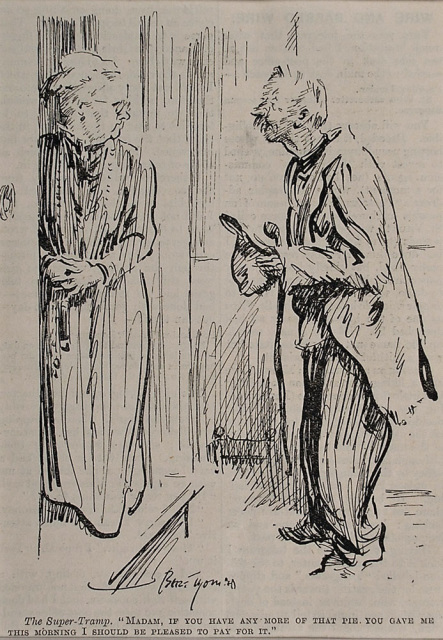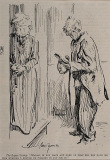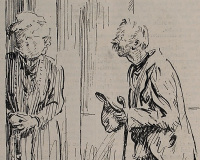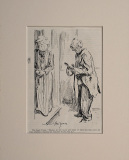- Decorative
- >
- Punch Cartoons
- >
- The Super-Tramp, 1920
The Super-Tramp, 1920
SKU:
20p1
£17.99
£17.99
Unavailable
per item
Bert Thomas (1883-1966)
Cartoon taken from a disbound copy of the Punch Almanack, 1920
In a cream conservation grade mount (matt)
In very good condition, as illustrated
Cartoon: 16.8 x 11.8 cm (visible); mount: 20.4 x 25.4 cm (8" x 10")
Visit our Frames page to view and select a frame for this work
Free delivery within the UK (we dispatch worldwide, too)
1 available
Bert Thomas (1883-1966)
Bert Thomas was born in Newport, Wales and was apprenticed to an engraver at the age of 14. He contributed cartoons to Punch for over forty years from 1905. ‘Of the artists who were particularly successful in the [First World] war, Bert Thomas, after Fougasse, was probably the best. His very individual line, broken as if he had dashed the idea down while it was still white-hot in his mind, was father like [Charles] Bairnsfather’s, though he was a far more varied artist and his jokes were generally better. He had some of the attack and speed of Raven Hill. His sometimes frenzied methods were effective for depicting action, less so for jokes that simply demanded some common-or-garden emotion like surprise. He drew a wider range of classes than most Punch artists.’ (Price, 1957).
Collections
British Museum
Imperial War Museum
University of Kent Cartoon Centre
Victoria and Albert Museum
Sources and further reading
Bryant M and Heneage S (1994), Dictionary of British Cartoonists and Caricaturists 1730-1980, Scolar Press
Dolman B (1981), A Dictionary of British Artists, 1929, Antique Collectors’ Club
Johnson J and Greutzner A (1999), British Artists 1880-1940, Antique Collectors’ Club
Price R G G (1957), A History of Punch, Collins
Waters G M (1975), Dictionary of British Artists 1900-1950, Eastbourne Fine Art
Bert Thomas was born in Newport, Wales and was apprenticed to an engraver at the age of 14. He contributed cartoons to Punch for over forty years from 1905. ‘Of the artists who were particularly successful in the [First World] war, Bert Thomas, after Fougasse, was probably the best. His very individual line, broken as if he had dashed the idea down while it was still white-hot in his mind, was father like [Charles] Bairnsfather’s, though he was a far more varied artist and his jokes were generally better. He had some of the attack and speed of Raven Hill. His sometimes frenzied methods were effective for depicting action, less so for jokes that simply demanded some common-or-garden emotion like surprise. He drew a wider range of classes than most Punch artists.’ (Price, 1957).
Collections
British Museum
Imperial War Museum
University of Kent Cartoon Centre
Victoria and Albert Museum
Sources and further reading
Bryant M and Heneage S (1994), Dictionary of British Cartoonists and Caricaturists 1730-1980, Scolar Press
Dolman B (1981), A Dictionary of British Artists, 1929, Antique Collectors’ Club
Johnson J and Greutzner A (1999), British Artists 1880-1940, Antique Collectors’ Club
Price R G G (1957), A History of Punch, Collins
Waters G M (1975), Dictionary of British Artists 1900-1950, Eastbourne Fine Art



